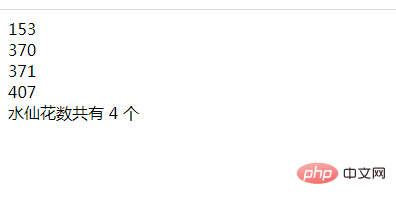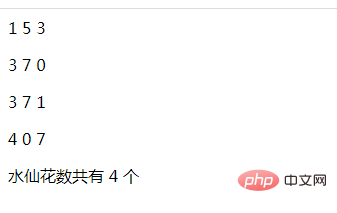 Backend Development
Backend Development
 PHP Tutorial
PHP Tutorial
 PHP loop learning ten: Determine the number of daffodils and print the number of all daffodils
PHP loop learning ten: Determine the number of daffodils and print the number of all daffodils
PHP loop learning ten: Determine the number of daffodils and print the number of all daffodils
In the previous article "PHP Loop Learning 9: Obtaining the greatest common factor between two given numbers", we introduced to you how to use the while loop statement to find the given two numbers in the PHP program. The greatest common divisor between two integers, let’s continue learning about PHP loops~
This article mainly shows you, given a three-digit integer, how to determine whether the number is a narcissus number? Then how to output the total number of daffodils.
First let’s take a lookWhat is the narcissus number?
The Narcissus number is a 3-digit number, the sum of the 3rd power of the numbers in each digit is equal to itself (for example: 1^3 5^3 3^3 = 153) .
Let’s first look at how to determine whether a given three-digit number is a narcissus number?
Idea analysis:
According to the above we know: If a number $num is a narcissus number, then it must satisfy: The 3rd power of the ones digit The 3rd power of the tens digit The 3rd power of the hundreds digit = $num itself
Then we can first decompose $num to get Digit $g, tens digit$s, hundreds digit$b
then judge $g^3 $^3 $b ^3 Is it equal to $num
Let’s look at the implementation code:
<?php
header("Content-type:text/html;charset=utf-8");
function is_narcissistic ( $num ){
$b= intval($num/100);
$s= ($num/10)%10;
$g= $num%10;
// if($b*$b*$b+$s*$s*$s+$g*$g*$g==$num){ 等价于
if(pow($b,3)+pow($s,3)+pow($g,3)==$num){
echo $num."是水仙花数<br>";
}else{
echo $num."不是水仙花数<br>";
}
}
is_narcissistic(153);
is_narcissistic(152);
?>Output result:

In the above example, pow($b,3) and $b*$b*$b are equivalent, and both can calculate the cube of $b ( $b^3). pow(x,y)The function can return x raised to the yth power, that is, x^y.
We know that the daffodil number is a 3-digit number, so it has a quota. So how to calculate and output all the daffodil numbers? This requires the use of loops.
You can use a for loop to limit the range to between 100 and 1000. Writing method:
<?php
header("Content-type:text/html;charset=utf-8");
$i=0;
for ( $num = 100; $num < 1000; $num++){
$b= intval($num/100);
$s= ($num/10)%10;
$g= $num%10;
if(pow($b,3)+pow($s,3)+pow($g,3)==$num){
echo $num."<br>";
$i++;
}
}
echo "水仙花数共有 $i 个";
?>Look at the output:

Except In the above method of calculating and outputting the number of all daffodils, you can also use 3 for loops to traverse each digit to output the number of all daffodils:
<?php
header("Content-type:text/html;charset=utf-8");
$i=0;
for($q=1;$q<=9;$q++){
for($w=0;$w<=9;$w++){
for($e=0;$e<=9;$e++){
if($q*$q*$q + $w*$w*$w + $e*$e*$e ==
100*$q + 10*$w + $e){
echo "$q $w $e "."<p>";
$i++;
}
}
}
}
echo "水仙花数共有 $i 个";
?>Look at the output result:

It can be seen that the output results are the same.
It can be seen that we use a counter $num in the loop body of the for loop. After each time a three-digit palindrome number is output, it increases by 1, so that Count how many palindromes there are between 100 and 999.
Okay, that’s all. If you want to know anything else, you can click this. → →php video tutorial
The above is the detailed content of PHP loop learning ten: Determine the number of daffodils and print the number of all daffodils. For more information, please follow other related articles on the PHP Chinese website!

Hot AI Tools

Undresser.AI Undress
AI-powered app for creating realistic nude photos

AI Clothes Remover
Online AI tool for removing clothes from photos.

Undress AI Tool
Undress images for free

Clothoff.io
AI clothes remover

Video Face Swap
Swap faces in any video effortlessly with our completely free AI face swap tool!

Hot Article

Hot Tools

Notepad++7.3.1
Easy-to-use and free code editor

SublimeText3 Chinese version
Chinese version, very easy to use

Zend Studio 13.0.1
Powerful PHP integrated development environment

Dreamweaver CS6
Visual web development tools

SublimeText3 Mac version
God-level code editing software (SublimeText3)

Hot Topics
 1666
1666
 14
14
 1426
1426
 52
52
 1328
1328
 25
25
 1273
1273
 29
29
 1253
1253
 24
24
 PHP and Python: Comparing Two Popular Programming Languages
Apr 14, 2025 am 12:13 AM
PHP and Python: Comparing Two Popular Programming Languages
Apr 14, 2025 am 12:13 AM
PHP and Python each have their own advantages, and choose according to project requirements. 1.PHP is suitable for web development, especially for rapid development and maintenance of websites. 2. Python is suitable for data science, machine learning and artificial intelligence, with concise syntax and suitable for beginners.
 PHP: A Key Language for Web Development
Apr 13, 2025 am 12:08 AM
PHP: A Key Language for Web Development
Apr 13, 2025 am 12:08 AM
PHP is a scripting language widely used on the server side, especially suitable for web development. 1.PHP can embed HTML, process HTTP requests and responses, and supports a variety of databases. 2.PHP is used to generate dynamic web content, process form data, access databases, etc., with strong community support and open source resources. 3. PHP is an interpreted language, and the execution process includes lexical analysis, grammatical analysis, compilation and execution. 4.PHP can be combined with MySQL for advanced applications such as user registration systems. 5. When debugging PHP, you can use functions such as error_reporting() and var_dump(). 6. Optimize PHP code to use caching mechanisms, optimize database queries and use built-in functions. 7
 PHP in Action: Real-World Examples and Applications
Apr 14, 2025 am 12:19 AM
PHP in Action: Real-World Examples and Applications
Apr 14, 2025 am 12:19 AM
PHP is widely used in e-commerce, content management systems and API development. 1) E-commerce: used for shopping cart function and payment processing. 2) Content management system: used for dynamic content generation and user management. 3) API development: used for RESTful API development and API security. Through performance optimization and best practices, the efficiency and maintainability of PHP applications are improved.
 PHP vs. Python: Understanding the Differences
Apr 11, 2025 am 12:15 AM
PHP vs. Python: Understanding the Differences
Apr 11, 2025 am 12:15 AM
PHP and Python each have their own advantages, and the choice should be based on project requirements. 1.PHP is suitable for web development, with simple syntax and high execution efficiency. 2. Python is suitable for data science and machine learning, with concise syntax and rich libraries.
 The Enduring Relevance of PHP: Is It Still Alive?
Apr 14, 2025 am 12:12 AM
The Enduring Relevance of PHP: Is It Still Alive?
Apr 14, 2025 am 12:12 AM
PHP is still dynamic and still occupies an important position in the field of modern programming. 1) PHP's simplicity and powerful community support make it widely used in web development; 2) Its flexibility and stability make it outstanding in handling web forms, database operations and file processing; 3) PHP is constantly evolving and optimizing, suitable for beginners and experienced developers.
 PHP vs. Other Languages: A Comparison
Apr 13, 2025 am 12:19 AM
PHP vs. Other Languages: A Comparison
Apr 13, 2025 am 12:19 AM
PHP is suitable for web development, especially in rapid development and processing dynamic content, but is not good at data science and enterprise-level applications. Compared with Python, PHP has more advantages in web development, but is not as good as Python in the field of data science; compared with Java, PHP performs worse in enterprise-level applications, but is more flexible in web development; compared with JavaScript, PHP is more concise in back-end development, but is not as good as JavaScript in front-end development.
 PHP and Python: Different Paradigms Explained
Apr 18, 2025 am 12:26 AM
PHP and Python: Different Paradigms Explained
Apr 18, 2025 am 12:26 AM
PHP is mainly procedural programming, but also supports object-oriented programming (OOP); Python supports a variety of paradigms, including OOP, functional and procedural programming. PHP is suitable for web development, and Python is suitable for a variety of applications such as data analysis and machine learning.
 PHP and Python: Code Examples and Comparison
Apr 15, 2025 am 12:07 AM
PHP and Python: Code Examples and Comparison
Apr 15, 2025 am 12:07 AM
PHP and Python have their own advantages and disadvantages, and the choice depends on project needs and personal preferences. 1.PHP is suitable for rapid development and maintenance of large-scale web applications. 2. Python dominates the field of data science and machine learning.



